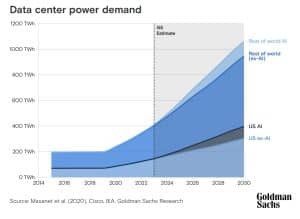A study by KnownHost revealed that Virginia’s data centers are under scrutiny for their significant environmental impact. With over 400 data centers in the state, these facilities emit nearly 200 tons of CO2 equivalent per megawatt-hour (MWh) of energy produced. As the demand for data centers continues to grow, especially with the rise of AI and cloud computing, concerns about their carbon footprint have intensified. This issue is particularly pressing in Virginia, where data center investments continue to rise. The increase in carbon emissions has raised questions about sustainability and the ability of the energy grid to handle this growth.
AI Boom Could Triple Data Center CO2 Emissions
Data centers are essential for powering the tech industry, processing, storing, and distributing vast amounts of information. As companies increasingly rely on AI and other advanced technologies, the need for more data centers is expected to soar. According to research from Goldman Sachs, demand for these facilities could jump by 160% by 2030. However, this rise also means an increase in power and environmental impact.

Virginia Tops the List for Data Center Carbon Emissions in the US
Research from KnownHost has identified Virginia as the state with the highest carbon intensity for its data centers.
-
The state houses 473 data centers, including 24 hyperscale centers and 449 colocation centers, which host servers for multiple companies.
With 70% of the world’s data centers located in Virginia, the state has seen a surge in investment. Yet, this growth comes at a cost. The study found that these centers emit nearly 200 tons of CO2 equivalent per MWh, making Virginia the worst in the U.S. for carbon intensity in data centers.
To understand the scale of these emissions, one MWh of energy produced by Virginia’s data centers releases the same amount of CO2 as 43 cars driven for an entire year. Despite the environmental concerns, investments continue to flood in. Recently, Google announced a $1 billion expansion of its data center in Reston, Virginia, further fueling the state’s data center boom.
Other High-Emission States
Following Virginia, Texas ranks second in carbon emissions from its data centers. The state operates 278 data centers, including four internal centers, 266 colocation centers, and eight hyperscale facilities. These data centers collectively emit 117 tons of CO2 equivalent per MWh. Investment in Texas’ data centers is expected to continue, with companies like Microsoft and DataBank planning significant expansions.
California, with 277 data centers, takes third place, emitting 116 tons of CO2 equivalent per MWh. Although California has one fewer data center than Texas, its emissions per workload are slightly higher. The massive energy consumption by data centers in California has raised concerns about the state’s power grid. In Santa Clara, 60% of the city’s energy is consumed by data centers, sparking fears of potential blackouts.
Ohio and Illinois round out the top five states for data center emissions, with Ohio emitting 65 tons of CO2 equivalent per MWh from its 156 data centers, and Illinois emitting 63 tons from 151 centers. These states have a high concentration of tech industry operations, further intensifying their environmental impact.
Check out the complete list here: Which Data Centers Produce the Most CO2 per MWh
States with Lower Carbon Emissions
States like Alaska, Montana, and Vermont are on the opposite end of the spectrum. These states have far fewer data centers and a lower-tech industry presence. Alaska, for example, has only two colocation centers, emitting just 0.84 tons of CO2 equivalent per MWh. A focus on renewable energy has helped mitigate Alaska’s emissions. One new data center in the state operates entirely on hydropower, offering a less carbon-intensive model for the industry.
Montana and Vermont follow closely, each with three colocation data centers and 1.26 tons of CO2 equivalent emissions per MWh. While the number of data centers is small in these states, there is growing concern that data center capacity in the Northwest, which includes Montana, Idaho, Oregon, and Washington, could surpass 4,000 MW by 2030. This projection highlights the need for increased investment in renewable energy to avoid energy shortages and reduce emissions.
As the tech industry continues to expand, the environmental impact of data centers is becoming more significant. Addressing carbon emissions and energy consumption will be critical to ensuring that the growth of data centers does not come at the expense of sustainability.
Disclaimer: Content disseminated for KnownHost
- FURTHER READING: The Carbon Countdown: AI and Its 10 Billion Rise in Power Use



